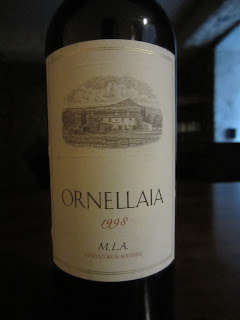A Wednesday and free from work tomorrow, so why not organize a tasting? Together with other wine enthusiasts, we gathered in a cellar in Helsinki for a treat. First, a mature bordeaux and a prized bordeaux blend from Tuscany, then off to other Italian treats.
1990 La Mission Haut Brion (Graves)

The bottle had been placed upwards and cork removed for some hours now, however the wine was still a bit murky initially. A beautiful medium intensive ruby color which was surprisingly young for a mature wine. And while the wine is already 22 years old, i.e. should be mature, the La Mission is so long-lived that the 1990 had not reached its peak yet, so think carefully if you want to open your bottle.
Dominated by red fruits, the nose is superb with nuances of ink, minerals, herbs and some leather. The mineral notes seems to be a trademark for Graves comparing to other bordeaux appellations. With the ink in nose, it gave you a world of blue colors mixed with red fruit should you close your eyes and just feel it.
However the palate was initially hard and steely, fortunately developing in the glass into a really smooth and velvety wine but not being able to shed all of the steely feeling. A slightly harsh aftertaste too. A problem with the bottle? You really need to decant this wine. Loads of syrapy fruit dominated by blueberries, sweet tannins, a great amount of fruit underlying there, and notes of chocolate and mocha developing after an hour.
Overall feeling is that it is a beautiful and maybe the most velvety wine I have ever tasted, however the steely and harsh aftertaste was somewhat disappointing. Need to try another bottle of these at some point.
Blend in 1990: 42% Cabernet Sauvignon, 48% Merlot, 10% Cabernet Franc
1998 Ornellaia (Bolgheri DOC, Tuscany)

Next up, a bordeaux blend from Tuscany, i.e. Supertuscan by Tenuta dell Ornellaia. The 1998 Ornellaia was WineSpectator's Wine of the Year in 2001 (96p). However a mixed review from Wine Advocate which gave it only 91 points. Well, we had to try and taste it ourselves.
The ruby color was more intensive than in La Mission Haut Brion. Nose was intensive with balsamico, sweet black cherries, chocolate and herbs dominating. The mouthfeel was like velvet. So smooth, the sweet cherries linger in your mouth a long time, tannins are present however nicely integrated. Palate follows the nose with licorice in the taste in addition. I will lean more to WineSpectator in this one. So did other tasters.
The blend in 1998 was 60% Cabernet Sauvignon, 35% Merlot and 5% Cabernt Franc.
1993 Flaccianello della Pieve, Fontodi (Colli della Toscana Centrale IGT)

This is interesting. I have 2001, 2004 and 2006 Flaccianellos in my cellar, however now it is time to taste a mature Flaccianello, a 100% sangiovese IGT from the Chianti region in Tuscany. The result of the tasting: do not even think of opening the 2001-2006 vintages in long time.
The 1993 Flaccianello was still youthful, altough had matured a bit. A medium intensive color, with some mature brownish mixed with ruby and an orange hue.
You could really notice olives in nose, which is so prominently Tuscan - just like you are able to notice lavender in many wines coming from Provence, France. Also sangiovese's trademark cherries which had developed into an almost syrapy feeling (although the wine being totally dry red). Got to love that.
Initially the mouthfeel was tight however opened up within over an hour. Both nose and taste got broader in the glass as time went by, the wine really needs air.
Loads of ripe fruit underlying there. A lot of acidity too, this is like eating a cherry containing a lot of acidity. Combining these factors, the wine feels at the same time like sweet ripe fruit and totally dry at the same time, the acidity obviously taking away the sweet feeling. Acidity maintains in the mouth really long, actually longer than what fruit is left.
Could be enjoyed now, however will absolutely get better with more cellaring (give it another 3 years). So enjoy this one at 22-25 years of age. So my 2001, 2004, 2006, see you in 20 years.
2002 Tassanaia (Toscana IGT)
Due to a very challenging year in 2002, Castello del Terricio did not make its flagship wine, Lupicaia, while the grapes were used in this Tassanaia.
Thus the 2002 Tassanaia could be better than other vintages, albeit poorer growing conditions. The producer achieved 14% abv although the vintage was marred by poor weather.
Already showing some age in the glass with slightly brownish and medium + intensive garnet color. The nose is full of blueberries, smoke, tobacco, spices and italian herbs. Really tannic too. Needs a lot of time for the abundant tannins to integrate, if they will ever. A really fruity tuscan, with blueberries taking the pole position in mouth accompanied by notes of plums, "cloves and pepper".
However the aftertaste is short, indicating that fruit was not totally ripe when picking. Blame it on weather. This is a blend of 30% CabSav, 30% Merlot and 40% Sangiovese.
1989 Produttori del Barbaresco (DOCG Barbaresco)
Medium garnet / almost brownish colour with orange hues, as in mature nebbiolo you would expect.
Some burned rubber in the nose, a trademark for mature nebbiolo too, along with tryffels, almonds, fried chestnuts and black fruit. Some slightly chemical notes there too, which however do not disturb at all.
Tannins are still big and tight in this one, and not nearly enough ripe fruit to balance it out. 13.5% abv. Some peppery feeling in mouth too.
Nose develops into licorice and burned sugar after spending over hour in the glass, increasing the enjoyment of sniffing this mature wine.